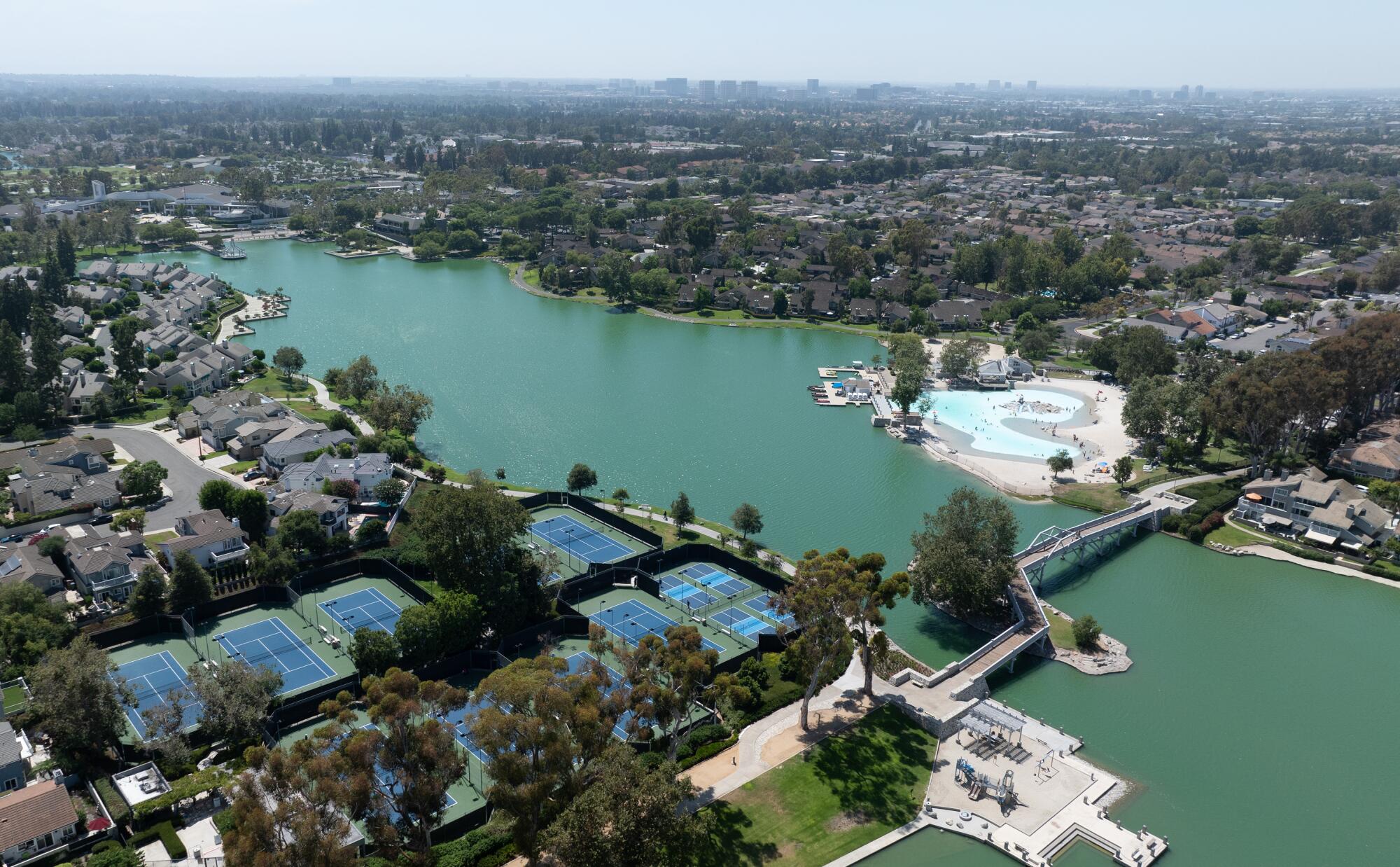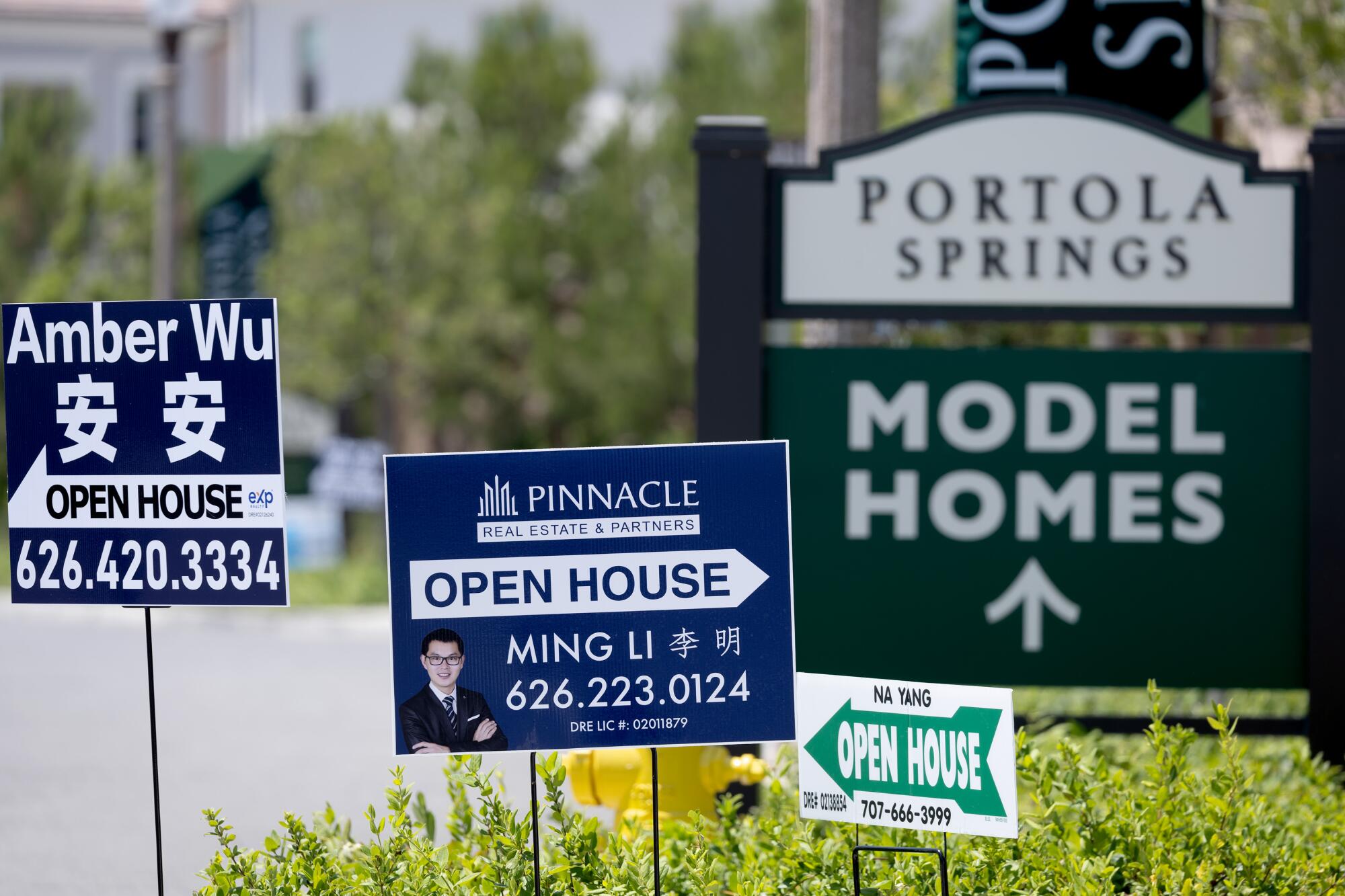
- Share via
After only a few months in her new one-bedroom condominium in Irvine’s booming Great Park community, Kim Pohas started paying attention to real estate prices again.
She loved her condo, which she bought in May 2023 for $643,000 within days of touring a model unit and deciding to splurge on upgrades to the floors and kitchen backsplash. But her Zillow alerts were telling her that values in her neighborhood were soaring.

Subscribers get exclusive access to this story
We’re offering L.A. Times subscribers special access to our best journalism. Thank you for your support.
Explore more Subscriber Exclusive content.
On a lark, Pohas listed the condo for sale. Then in late May, a year after her purchase, came an offer too good to pass up: $821,000.
“It’s like I flipped a house but I didn’t do anything to it,” said Pohas, 40. “It’s brand-new construction. I just lived there.”

Pohas’ tale sounds straight from the pandemic era of rocketing home prices and frantic bidding — not today’s period of stagnant values and market-crippling mortgage rates. But Irvine is defying the trend.
Over the last year, median home values have surged to $1.56 million in the central Orange County city, an increase of 20.8%, which is the highest in the country, according to a review of Zillow data by real estate analyst Home Economics.
It’s not just prices. Irvine is also outperforming California communities in growth and homebuilding. Whereas Los Angeles, San Francisco and other big cities have shed people by the thousands, Irvine has added more than 13,000 residents in the last three years, the most in the state. During that time, the city, now with a population of 315,000, jumped ahead of Santa Ana to become California’s 13th largest. Of the nearly 100,000 net new homes built in Orange County since 2010, more than one-third, 35,000, have been in Irvine.
The city’s popularity is nothing new. It’s more the continued affirmation of one of the nation’s largest master-planned communities. Six decades ago, the Irvine Co. began turning what was 100,000 acres of cattle pastures, bean fields and citrus groves into a series of self-contained suburban villages. Over time, Irvine built a reputation for excellent public schools, low crime and plentiful park space. Combined with the economic engine of UC Irvine and high-end office towers, the community remains a haven for upwardly mobile families, notably in recent decades, those arriving from East Asia.
“It’s such a clean, safe city that still has room to add more housing and jobs,” said John Burns, chief executive of Irvine-based John Burns Real Estate Consulting. “Nothing else in Southern California is like that.”
Irvine has attracted wild exuberance among homebuyers throughout its history. The Irvine Co.’s development plan began in 1960 when it gave 1,000 acres to the state for a university to serve as the new community’s anchor. Then it built residential centers made up of single-family homes, townhomes and apartments, each with their own schools, retail and playgrounds. Arterial roads connected the neighborhoods to business parks and greenbelts.

When Woodbridge, one of Irvine’s best known areas, opened in 1976, 10,000 people gathered in a frenzy at the sales office, according to “Transforming the Irvine Ranch,” a book chronicling the city’s history. An Irvine Co. executive compared the scene to the Oklahoma land rush.
Arrays of homeowner associations and special taxing districts oversee the villages, and the Irvine Co. maintains a heavy hand in the city. Three-quarters of the more than 40,000 apartment units in Irvine remain under its ownership, per data from the real estate firm CoStar.
Some residents have described the manicured sameness as stultifying, but the high-quality amenities and lifestyle have garnered deep devotees.
Jonathan Sun, 37, bought a new condo in Irvine in 2017, then married and upgraded to a new four-bedroom home with his wife two years later. He said that the village concept with houses, schools, parks and shops all nearby makes life convenient.
“Everything is just very neat and well organized,” said Sun, a tech worker.
Irvine’s population more than doubled between 2000 and 2020. Though it lost people in the first year of the COVID-19 pandemic, growth — at least by California’s sluggish standards — has roared back. A net 6,200 people moved into a ZIP Code in northeast Irvine between 2019 and 2022, the most of any in Southern California, according to a Times analysis of U.S. Postal Service data.
That area includes Great Park, a Marine air base that when retired left 4,700 acres empty. A lengthy debate over the land’s future, including a push to turn it into a new commercial airport, was settled in 2002 in favor of residential development. About a quarter of the site is set aside for parks, and the city is planning for as many as 15,800 homes.

Construction in Great Park allows Irvine to continue to far outpace surrounding communities in homebuilding. In the last five years, the 9,400 homes permitted in Irvine is double the next largest amount of any other Orange County city, according to U.S. Census data.
New three-story, three- and four-bedroom townhomes with small balconies and two-car garages cluster on small lots in Great Park’s Solis Park section. Freshly painted yellow crosswalks mark the way to a K-8 school. Prices for the townhomes listed at recent open houses range from $1.5 million to $1.8 million.
But analysts said Irvine’s new supply still is being outpaced by demand, especially since the city serves as one of Orange County’s employment centers.
“The most amazing thing in Irvine is the really strong job growth,” Burns said. “The jobs are in Irvine.”
Surrounding areas have seen significant price appreciation. Besides Irvine, four other spots in Orange County — Laguna Niguel, Tustin, Lake Forest and Mission Viejo — are in the top 12 of cities nationally with the highest percentage increases in home values over the last year, per Zillow.
Chang “Emily” Calcote, a real estate broker who has worked in Irvine for a decade, said growth in the nearby communities comes from house seekers who were priced out of Irvine.
Driving the recent surge, she said, were foreign buyers from Asia who have long been attracted to Irvine for the K-12 schools, the university and its other amenities. Nearly 40% of Irvine’s population is foreign born, 80% of which is from Asian countries, according to census data. Today, a plurality of Irvine’s residents, 44%, are Asian, the data show.
Irvine’s reputation spreads by word of mouth among Asian families with the means to buy, Calcote said.

“You could talk to a Chinese or Korean person and they would know Irvine,” Calcote said. “They may not even know California, but they know Irvine.”
Foreign buyers, who often pay in cash or borrow outside the traditional mortgage market, aren’t as sensitive to higher rates. These owners may be moving to Irvine or just looking for a safe place to park their money. Orange County is one of the rare spots in the country where investor activity has been accelerating, according to research from Burns’ firm.
Liu Guanyi of Shanghai paid $2 million in June for a new four-bedroom house in Irvine’s Portola Springs community. In the next few years, he plans to move in with his family.
He was already well acquainted with Irvine. In 2019, he and his wife had traveled there for the birth of their first child so she could be a U.S. citizen. Afterward, he bought a house in Irvine, another in Anaheim and the new one is his third in Orange County.
Like many in China, Liu said, he is impressed by Irvine’s schools and low crime rate. He wants an American education for his daughter and 6-month-old son.
“We feel like the American educational system is still the best in the world, so we thought we would give our kids a broader perspective,” said Liu, 38, who owns a company that makes car window coatings.
The Chinese government’s harsh lockdowns during the pandemic accelerated Liu’s timetable for relocating. He is applying for a green card through the EB-5 immigrant investor program.
The run-up in prices has left even some of Irvine’s winners feeling stuck. Now with 4- and 1-year-old children, Sun and his wife want to move to a larger place. Despite the significant appreciation in their current home’s value, they’re striking out.
At a $2.7-million budget, the houses they’re looking at need work or aren’t much bigger than the 2,200 square feet they’re in now, Sun said.
“We could probably sell and move north or south in Orange County and get exactly what we want, but it’s our choice to stay,” he said.
Large-scale construction in Irvine extends beyond Great Park. Last year, in keeping with greater demand for housing compared with office space, the Irvine Co. agreed to build up to 4,900 new apartments on half a dozen sites previously planned for commercial development. The city reached a deal with developer Brookfield in the spring for 1,200 new homes, most of which will be single-family, as part of an agreement to shutter a nearby asphalt plant.

After she cashed out of her Great Park condominium in the spring, Pohas moved into a two-bedroom apartment in Irvine with her boyfriend and the three dogs they share. She poured her profit from the sale into a high-interest savings account. That’s to keep her money liquid for when mortgage rates come down, she said.
“I want to be ready to buy again,” Pohas said.
Times staff writers Terry Castleman and Sandhya Kambhampati contributed to this report.
Sign up for This Evening's Big Stories
Catch up on the day with the 7 biggest L.A. Times stories in your inbox every weekday evening.
You may occasionally receive promotional content from the Los Angeles Times.
More to Read
Sign up for This Evening's Big Stories
Catch up on the day with the 7 biggest L.A. Times stories in your inbox every weekday evening.
You may occasionally receive promotional content from the Los Angeles Times.









